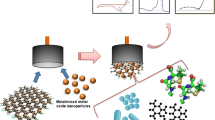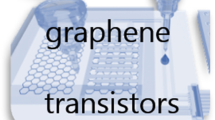Abstract
This work describes fabrication of a DNA electrochemical sensor utilized of gold nanoparticles/silicon nanowires/indium tin oxide (AuNPs/SiNWs/ITO) as a modified substrate for detection of dengue virus DNA oligomers using methylene blue (MB) as a redox indicator. The response surface methodology (RSM) was applied as one of the advanced optimization methods for fabrication of SiNWs/AuNPs/ITO electrode and immobilization of DNA probes to enhance the sensitivity of DNA detection. Several factors were successfully optimized using RSM, including volume of SiNWs, concentration of dithiopropionic acid (DTPA), volume of AuNPs, DNA probe concentration, and DNA probe immobilization time. RSM approach shows that AuNPs and DNA probe concentration were the prominent factors affecting on the MB current signal and immobilization of DNA probe on AuNPs/SiNWs surface. This new developed sensor was able to discriminate complementary target sequences, noncomplementary and single-base mismatch sequences, for DNA dengue virus detection.










Similar content being viewed by others
References
Cui H-F, Cheng L, Zhang J, Liu R, Zhang C, Fan H (2014) An electrochemical DNA sensor for sequence-specific DNA recognization in a homogeneous solution. Biosens Bioelectron 56:124–128
Li F, Chen W, Zhang S (2008) Development of DNA electrochemical biosensor based on covalent immobilization of probe DNA by direct coupling of sol–gel and self-assembly technologies. Biosens Bioelectron 24(4):781–786
Zhang C, Xu S, Zhang X, Huang D, Li R, Zhao S, Wang B (2014) Electrochemical detection of specific DNA sequences related to bladder cancer on CdTe quantum dots modified glassy carbon electrode. J Electroanal Chem 735:115–122
Sassolas A, Leca-Bouvier BD, Blum LJ (2008) DNA biosensors and microarrays. Chem Rev 108(1):109–139
Chowdhury AD, Gangopadhyay R, De A (2014) Highly sensitive electrochemical biosensor for glucose, DNA and protein using gold-polyaniline nanocomposites as a common matrix. Sens Actuators B Chem 190:348–356
Rashid JIA, Yusof NA, Abdullah J, Hashim U, Hajian R (2014) The utilization of SiNW/AuNP-modified indium tin oxide (ITO) in fabrication of electrochemical DNA sensor. Mater Sci Eng C 45:270–276
Rashid J, Yusof N, Abdullah J, Hashim U, Hajian R (2015) A novel disposable biosensor based on SiNWs/AuNPs modified-screen printed electrode for dengue virus DNA oligomer detection. IEEE Sens J. doi:10.1109/JSEN.2015.2417911
Farjami E, Clima L, Gothelf K, Ferapontova EE (2010) DNA interactions with a methylene blue redox indicator depend on the DNA length and are sequence specific. Analyst 135:1443–1448. doi:10.1039/c0an00049c
Velusamy V, Arshak K, Yang CF, Yu L, Korostynska O, Adley C (2011) Comparison between DNA immobilization techniques on a redox polymer matrix. Am J Anal Chem 2:392–400. doi:10.4236/ajac.2011.23048
Qi X, Gao H, Zhang Y, Wang X, Chen Y, Sun W (2012) Electrochemical DNA biosensor with chitosan-Co3O4 nanorod-graphene composite for the sensitive detection of Staphylococcus aureus nuc gene sequence. Bioelectrochemistry 88:42–47. doi:10.1016/j.bioelechem.2012.05.007
Primo EN, Belén Oviedo M, Sánchez CG, Rubianes MD, Rivas GA (2014) Bioelectrochemical sensing of promethazine with bamboo-type multiwalled carbon nanotubes dispersed in calf-thymus double stranded DNA. Bioelectrochemistry. doi:10.1016/j.bioelechem.2014.05.002
Shi A, Wang J, Han X, Fang X, Zhang Y (2014) A sensitive electrochemical DNA biosensor based on gold nanomaterial and graphene amplified signal. Sens Actuators B Chem 200:206–212. doi:10.1016/j.snb.2014.04.024
Yang L, Lin H, Zhang Z, Cheng L, Ye S, Shao M (2013) Gas sensing of tellurium-modified silicon nanowires to ammonia and propylamine. Sens Actuators B Chem 177:260–264
Oh JY, Jang H-J, Cho W-J, Islam MS (2012) Highly sensitive electrolyte-insulator-semiconductor pH sensors enabled by silicon nanowires with Al2O3SiO2 sensing membrane. Sens Actuators B Chem 171:238–243
Rashid JIA, Abdullah J, Yusof NA, Hajian R (2013) The development of silicon nanowire as sensing material and its applications. J Nanomater 2013:1–16. doi:10.1155/2013/328093
Yan Q, Wang Z, Zhang J, Peng H, Chen X, Hou H, Liu C (2012) Nickel hydroxide modified silicon nanowires electrode for hydrogen peroxide sensor applications. Electrochim Acta 61:148–153. doi:10.1016/j.electacta.2011.11.098
Su S, He Y, Zhang M, Yang K, Song S, Zhang X, Fan C, Lee S-T (2008) High-sensitivity pesticide detection via silicon nanowires-supported acetylcholinesterase-based electrochemical sensors. Appl Phys Lett 93(2):023113. doi:10.1063/1.2959827
Kwon DH, An HH, Kim H-S, Lee JH, Suh SH, Kim YH, Yoon CS (2011) Electrochemical albumin sensing based on silicon nanowires modified by gold nanoparticles. Appl Surf Sci 257(10):4650–4654. doi:10.1016/j.apsusc.2010.12.109
Chen W, Yao H, Tzang CH, Zhu J, Yang M, Lee S-T (2006) Silicon nanowires for high-sensitivity glucose detection. Appl Phys Lett 88(21):213104. doi:10.1063/1.2206102
Su S, Wei X, Guo Y, Zhong Y, Su Y, Huang Q, Fan C, He Y (2013) A Silicon nanowire-based electrochemical sensor with high sensitivity and electrocatalytic activity. Part Part Syst Charact 30(4):326–331. doi:10.1002/ppsc.201200076
Tao B, Zhang J, Hui S, Wan L (2009) An amperometric ethanol sensor based on a Pd–Ni/SiNWs electrode. Sens Actuators B Chem 142(1):298–303. doi:10.1016/j.snb.2009.08.004
Yang K, Wang H, Zou K, Zhang X (2006) Gold nanoparticle modified silicon nanowires as biosensors. Nanotechnology 17(11):S276–S279. doi:10.1088/0957-4484/17/11/s08
Myers RH, Anderson-Cook CM (2009) Response surface methodology: process and product optimization using designed experiments, vol 705. Wiley, New York
Rashid A, Izuan J, Samat N, Wan Yusoff WM (2011) Optimization of temperature, moisture content and inoculum size in solid state fermentation to enhance mannanase production by Aspergillus terreus SUK-1 using RSM. Pak J Biol Sci 14(9):533–539
Rashid JIA, Samat N, Yusoff WMW (2012) Screening and optimization of medium composition for mannanase production by Aspergillus terreus SUK-1 in solid state fermentation using statistical experimental methods. Res J Microbiol 7(5):242
Alizadeh T, Zare M (2009) Enhancement of sensitivity of molecularly imprinted polymer based parathion voltammetric sensor by using experimental design technique. Anal Bioanal Electrochem 2009(3):169–187
Uliana CV, Riccardi CS, Tognolli JO, Yamanaka H (2008) Optimization of an amperometric biosensor for the detection of hepatitis C virus using fractional factorial designs. J Braz Chem Soc 19(4):782–787
Mirmoghtadaie L, Ensafi AA, Kadivar M, Norouzi P (2013) Highly selective electrochemical biosensor for the determination of folic acid based on DNA modified-pencil graphite electrode using response surface methodology. Mater Sci Eng C 33(3):1753–1758
Urkut Z, Kara P, Goksungur Y, Ozsoz M (2011) Response surface methodology for optimization of food borne pathogen detection in real samples based on label free electrochemical nucleic acid biosensors. Electroanalysis 23(11):2668–2676. doi:10.1002/elan.201100310
Nasir SH, Hadi N (2008) Gold nanoparticles embedded on the surface of polyvinyl alcohol layer. J Fundam Sci 4:245–252
Yguerabide J, Yguerabide EE (1998) Light-scattering submicroscopic particles as highly fluorescent analogs and their use as tracer labels in clinical and biological applications: I. Theory. Anal Biochem 262(2):137–156
Luo C, Tang H, Cheng W, Yan L, Zhang D, Ju H, Ding S (2013) A sensitive electrochemical DNA biosensor for specific detection of Enterobacteriaceae bacteria by Exonuclease III-assisted signal amplification. Biosens Bioelectron 48:132–137. doi:10.1016/j.bios.2013.03.084
Jain R, Sharma S (2012) Glassy carbon electrode modified with multi-walled carbon nanotubes sensor for the quantification of antihistamine drug pheniramine in solubilized systems. J Pharm Anal 2(1):56–61
Aydogdu G, Zeybek DK, Pekyardimci S, Kiliç E (2013) A novel amperometric biosensor based on ZnO nanoparticles-modified carbon paste electrode for determination of glucose in human serum. Artif Cells Nanomed Biotechnol 41(5):332–338
S-f Liu, Y-f Li, J-r Li, Jiang L (2005) Enhancement of DNA immobilization and hybridization on gold electrode modified by nanogold aggregates. Biosens Bioelectron 21(5):789–795
Ilkhani H, Arvand M, Ganjali MR, Marrazza G, Mascini M (2013) Nanostructured screen printed graphite electrode for the development of a novel electrochemical genosensor. Electroanalysis 25(2):507–514
Chen L, Zhang L, Qiu T, Cao W (2011) Chemiluminescent detection of DNA hybridization based on signal DNA probe modified with gold and cobalt nanoparticles. Int J Electrochem Sci 6:5325–5336
Liu S, Liu J, Wang L, Zhao F (2010) Development of electrochemical DNA biosensor based on gold nanoparticle modified electrode by electroless deposition. Bioelectrochemistry 79(1):37–42. doi:10.1016/j.bioelechem.2009.10.005
Hezard T, Fajerwerg K, Evrard D, Collière V, Behra P, Gros P (2012) Gold nanoparticles electrodeposited on glassy carbon using cyclic voltammetry: application to Hg(II) trace analysis. J Electroanal Chem 664:46–52
Bettazzi F, Lucarelli F, Palchetti I, Berti F, Marrazza G, Mascini M (2008) Disposable electrochemical DNA-array for PCR amplified detection of hazelnut allergens in foodstuffs. Anal Chim Acta 614(1):93–102
Pournaghi-Azar M, Hejazi M, Alipour E (2006) Developing an electrochemical deoxyribonucleic acid (DNA) biosensor on the basis of human interleukine-2 gene using an electroactive label. Anal Chim Acta 570(2):144–150
Loaiza ÓA, Campuzano S, López-Berlanga M, Pedrero M, Pingarrón JM (2005) Development of a DNA sensor based on alkanethiol self-assembled monolayer-modified electrodes. Sensors 5(6):344–363
Alegret S, Merkoçi A (2007) Electrochemical sensor analysis, vol 49. Elsevier, Amsterdam
Souza E, Nascimento G, Santana N, Danielly F, Lima M, Natividade E, Martins D, Lima-Filho J (2011) Label-free electrochemical detection of the specific oligonucleotide sequence of dengue virus type 1 on pencil graphite electrodes. Sensors 11:5616–5629
Oliveira N, Souza E, Ferreira D, Zanforlin D, Bezerra W, Borba MA, Arruda M, Lopes K, Nascimento G, Martins D (2015) A sensitive and selective label-free electrochemical DNA biosensor for the detection of specific dengue virus serotype 3 sequences. Sensors 15(7):15562–15577
Tedjo A, Ibrahim AS, Kusmardi (2010) Photoelectrochemical detection of dengue-related oligonucleotide sequence using anthocyanin as a intercalating agent and electrochromic material. Makara Seri Kesehatan 14(2):70–74
Ribeiro Teles FR, França dos Prazeres DM, de Lima-Filho JL (2007) Electrochemical detection of a dengue-related oligonucleotide sequence using ferrocenium as a hybridization indicator. Sensors 7(11):2510–2518
Iyer MA, Oza G, Velumani S, Maldonado A, Romero J, Muñoz MdL, Sridharan M, Asomoza R, Yi J (2014) Scanning fluorescence-based ultrasensitive detection of dengue viral DNA on ZnO thin films. Sens Actuators B Chem 202:1338–1348
Deng J, Toh CS (2013) Impedimetric DNA biosensor based on a nanoporous alumina membrane for the detection of the specific oligonucleotide sequence of dengue virus. Sensors 13:7774–7785. doi:10.3390/s130607774
Huang S, Li C, Lin B, Qin J (2010) Microvalve and micropump controlled shuttle flow microfluidic device for rapid DNA hybridization. Lab Chip 10:2925–2931. doi:10.1039/c005227b
Zhang G-J, Zhang L, Huang MJ, Luo ZHH, Tay GKI, Lim E-JA, Kang TG, Chen Y (2010) Silicon nanowire biosensor for highly sensitive and rapid detection of Dengue virus. Sens Actuators B Chem 146(1):138–144
Rai V, Hapuarachchi HC, Ng LC, Soh SH, Leo YS, Toh C-S (2012) Ultrasensitive cDNA detection of dengue virus RNA using electrochemical nanoporous membrane-based biosensor. PLoS ONE 7(8):e42346
Senapati S, Slouka Z, Shah SS, Behura SK, Shi Z, Stack MS, Severson DW, Chang H-C (2014) An ion-exchange nanomembrane sensor for detection of nucleic acids using a surface charge inversion phenomenon. Biosens Bioelectron 60:92–100
Zaytseva NV, Montagna RA, Baeumner AJ (2005) Microfluidic biosensor for the serotype-specific detection of dengue virus RNA. Anal Chem 77(23):7520–7527
Díaz-Badillo A, Muñoz ML, Ramirez GL, Altuzar V, Burgueño J, Alvarez JGM, Muñoz JPM, Cisneros A, Espinosaand JN, Sinencio FS (2014) A DNA microarray-based assay to detect dual infection with two dengue virus serotypes. Sensors 14:7580–7601. doi:10.3390/s140507580
Abdul Rahman S, Saadun R, Azmi NE, Ariffin N, Abdullah J, Yusof NA, Sidek H, Hajian R (2014) Label-free dengue detection utilizing PNA/DNA hybridization based on the aggregation process of unmodified gold nanoparticles. J Nanomater 2014:1–5. doi:10.1155/2014/839286
Nascimento HP, Oliveira MD, de Melo CP, Silva GJ, Cordeiro MT, Andrade CA (2011) An impedimetric biosensor for detection of dengue serotype at picomolar concentration based on gold nanoparticles-polyaniline hybrid composites. Colloids Surf B 86(2):414–419
Lee Yu HL, Montesa CM, Rojas NSL, Enriquez EP (2012) Nucleic-acid based lateral flow strip biosensor via competitive binding for possible dengue detection. J Biosens Biolectron 3(5):128. doi:10.4172/2155-6210.1000128
Chen S-H, Chuang Y-C, Lu Y-C, Lin H-C, Yang Y-L, Lin C-S (2009) A method of layer-by-layer gold nanoparticle hybridization in a quartz crystal microbalance DNA sensing system used to detect dengue virus. Nanotechnology 20(21):215501
Ngo HT, Wang HS, Fales A, Nicholson B, Woods CW, Vo-Dinh T (2014) DNA bioassay-on-chip using SERS detection for dengue diagnosis. Analyst 139:5655–5659. doi:10.1039/c4an01077a
Acknowledgements
This research was support by the Ministry of Science, Technology and Innovation (MOSTI) with Grant number NND/ND/(1)/TD11-008 under the National Nanotechnology Directorate (NND).
Author information
Authors and Affiliations
Corresponding authors
Ethics declarations
Conflict of interest
No conflict of interest.
Rights and permissions
About this article
Cite this article
Abdul Rashid, J.I., Yusof, N.A., Abdullah, J. et al. Surface modifications to boost sensitivities of electrochemical biosensors using gold nanoparticles/silicon nanowires and response surface methodology approach. J Mater Sci 51, 1083–1097 (2016). https://doi.org/10.1007/s10853-015-9438-6
Received:
Accepted:
Published:
Issue Date:
DOI: https://doi.org/10.1007/s10853-015-9438-6




